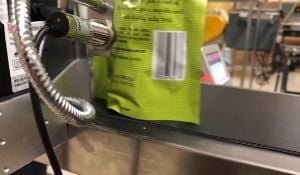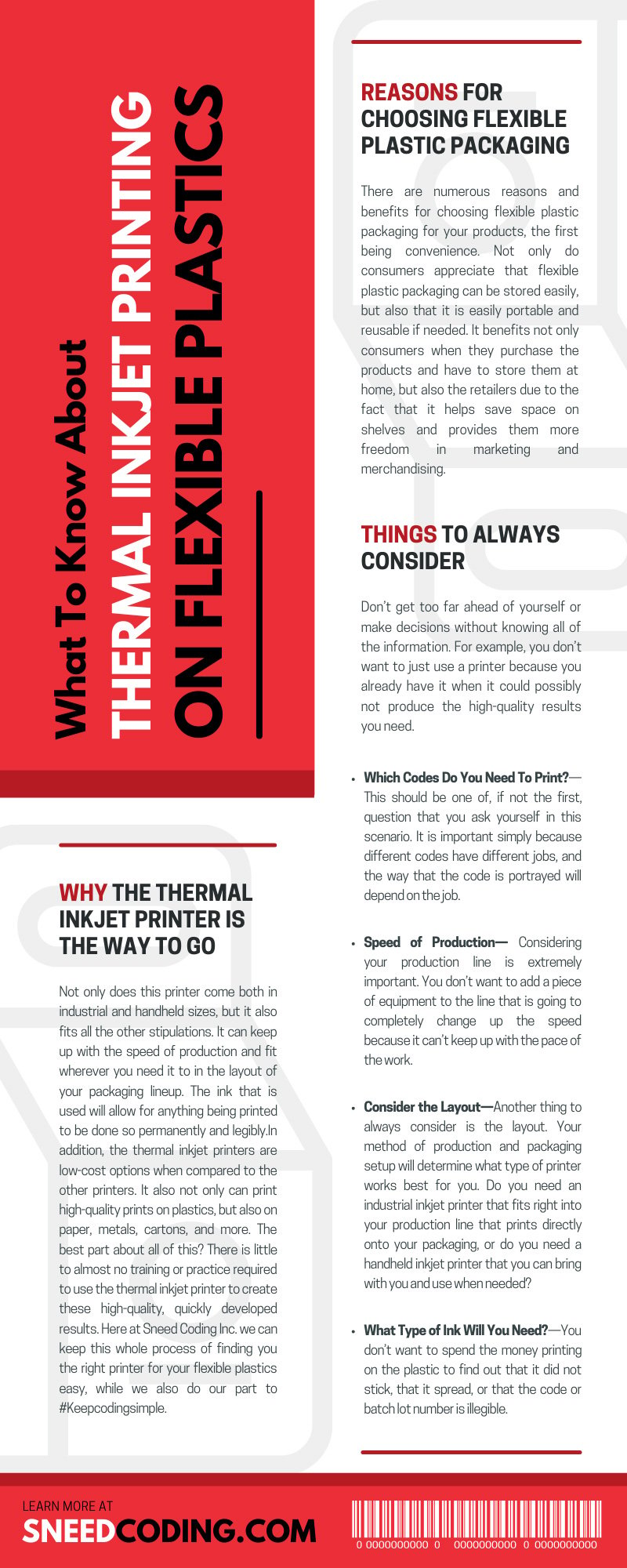
Your favorite bag of chips, frozen vegetables, favorite bag or box of candy, or pre-packaged cookies all have at least one thing in common—flexible plastic packaging. What exactly does that even mean? Well, lucky for you we are going to tell you everything that you need to know when using flexible plastics as packaging for your business. When producing and distributing any product, packaging is a large factor, and products use flexible plastics in many scenarios.
Whether you’re starting a new business or you’re looking for new and efficient ways to improve your business, it might be to your benefit to educate yourself on flexible plastics in general. Start by reading this material below that covers exactly what to know about thermal inkjet printing on flexible plastics. Before you know it, you will be well-versed in printing on flexible plastics and one step closer to improving your business venture!
Reasons for Choosing Flexible Plastic Packaging
There are numerous reasons and benefits for choosing flexible plastic packaging for your products, the first being convenience. Not only do consumers appreciate that flexible plastic packaging can be stored easily, but also that it is easily portable and reusable if needed. It benefits not only consumers when they purchase the products and have to store them at home, but also the retailers due to the fact that it helps save space on shelves and provides them more freedom in marketing and merchandising.
In addition to its convenience, flexible plastic packaging options also are a huge cost saver. Producing this flexible plastic uses significantly less materials than creating and producing boxes and solid packaging options. So, not only does it save money overall for a business, but it also helps the earth. Fewer materials being used in the manufacturing process leads directly to less waste. Now, that is what we call a win-win situation!
Things To Always Consider
Don’t get too far ahead of yourself or make decisions without knowing all of the information. For example, you don’t want to just use a printer because you already have it when it could possibly not produce the high-quality results you need. You also do not want to jump the gun and make purchasing decisions or decisions in general without knowing all the facts. So, here is an outline of what exactly you should consider.
- Which Codes Do You Need To Print?— This should be one of, if not the first, question that you ask yourself in this scenario. It is important simply because different codes have different jobs, and the way that the code is portrayed will depend on the job. For example, one does not print barcodes the same way they print best-by dates. Outlining what exactly you will print on your flexible plastics is key in determining the rest.
- Speed of Production— Considering your production line is extremely important. You don’t want to add a piece of equipment to the line that is going to completely change up the speed because it can’t keep up with the pace of the work.
- Consider the Layout— Another thing to always consider is the layout. Your method of production and packaging setup will determine what type of printer works best for you. Do you need an industrial inkjet printer that fits right into your production line that prints directly onto your packaging, or do you need a handheld inkjet printer that you can bring with you and use when needed? Considering your options and determining your needs is a must.
- What Type of Ink Will You Need?— You don’t want to spend the money printing on the plastic to find out that it did not stick, that it spread, or that the code or batch lot number is illegible. What is the point of even printing onto the plastic if it’s not legible or doesn’t stick? Keep in mind the color of the plastic matters as well. Not only is that a waste of money and time if it doesn’t work, but it also causes many other issues for your business later. Identifying what type of ink works best for printing on your flexible plastic is a necessity.
Why The Thermal Inkjet Printer Is The Way To Go
After you have considered all the information above, it would be shocking if you didn’t conclude that thermal inkjet technology is the way to go. Not only does this printer come both in industrial and handheld sizes, but it also fits all the other stipulations. It can keep up with the speed of production and fit wherever you need it to in the layout of your packaging lineup. The ink that is used will allow for anything being printed to be done so permanently and legibly.
In addition, the thermal inkjet printers are low-cost options when compared to the other printers. It also not only can print high-quality prints on plastics, but also on paper, metals, cartons, and more. The best part about all of this? There is little to almost no training or practice required to use the thermal inkjet printer to create these high-quality, quickly developed results.
Speaking of thermal inkjet printer options and what to know about thermal inkjet printing on flexible plastics, here at Sneed Coding Inc. we can keep this whole process of finding you the right printer for your flexible plastics easy, while we also do our part to #Keepcodingsimple. We have the best thermal inkjet printer options available for you. Whether you need a small handheld device for your local small business, or you need multiple industrial size printers for your large production line—we’ve got it all.
Feel free to visit our website and check out our inventory. Also, give us a call if you have any questions regarding the products or need assistance purchasing the products. Our professionals here at Sneed Coding Inc. want to help you not only find the right printer for you, but also make your experience working with us an amazing one.



